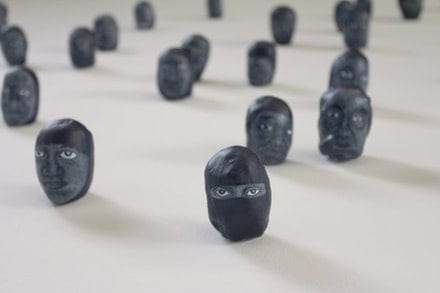
Toward (detail), 2012, wall installation, white pencil, blue acrylic paint, porcelain, dimensions variable
LUISA RABBIA Coming and Going
By Stephanie Buhmann
October 1, 2012
Though Luisa Rabbia works in various media, the core of her practice resides in drawing. It remains a significant component even when she is working in sculpture or film. This show, which marks Rabbia’s first solo project with the gallery, offers a thorough introduction by bringing together recent large-scale works on paper and a selection of sculptures, in addition to a monumental wall installation.
In the past, Rabbia has described drawing as a record of the development of an idea. In fact, her work allows for both a sense of spontaneity and the passage of time. In two works on paper, “Traces (3)” and “Traces (2),” fine lines made with silver point are built up slowly. They span half the picture plane, growing from delicate tracings into more densely layered networks. White and light grays on off-white make for an ethereal palette, forcing the viewer to look closely and intently. These compositions, which are characterized by a strict horizon line, translate as otherworldly landscapes, formations of large bodies of water, or the microscopically studied creases of an aging skin.
In contrast, Rabbia’s sculptures, which often involve recycled fabric, wood, and papier-mâché, appear more concrete. They are predominantly dark blue with occasional red accents, a contrast that references illustrations of veins and arteries. Biomorphic, elegant and convoluted, they evoke root systems, organs, navel chords or in one case, a pregnant stomach. Elongated heads, which grow out and upward, reveal faces that have been drawn in white pencil. These sculptures manifest as clusters of life matter, abstract body parts and people. They are physically linked together, deeply intertwined, and formally co-dependent, providing a metaphor for Rabbia’s key source of inspiration: interconnectivity. The latter she addresses relentlessly, observing it between objects, places, people, and cultures.
Her monumental installation entitled “Toward” (2012), which features about 200 miniature portraits on egg-shaped porcelain objects, serves as a potent metaphor for the global web of humans. From afar, each of the many blue objects appears as a mere pixel of a larger image. Upon closer inspection however, and only when viewed directly from below, one discovers intricate drawings of faces done in white pencil. Rabbia is a skilled draftsman to whom a realistic rendition comes easy. What sets her work apart, however, is her sincere interest in the human condition. Rather than simply describing figures, her portraits seem to depict real individuals, who stem from diverse backgrounds and whose expressions are psychologically charged. Rabbia’s work avoids stereotypes and instead, points to the fact that all people are bound together because they must co-exist. In the context of “Toward,” individuals remain unique while also becoming unified, despite possible cultural or social differences.
Stylistically, Rabbia’s oeuvre avoids categorization. Aspects of it allude to the work of Louise Bourgeois or Hans Bellmer, as well as to African ritualistic objects. Her sources of inspiration are eclectic and her viewpoint encompassing. This might be partially due to her geographic background. While currently based in Brooklyn, Rabbia originally hails from Turin, Italy, a city whose contemporary life is in part shaped by its many immigrants from Africa, Eastern Europe, and Asia. Now an immigrant herself, she is keenly aware of the impact that deeply rooted but also uprooted cultures can have on society. In this context, her work serves as a form of meeting ground—a hotbed for various influences and storylines. Rabbia has created a place where memories prevail and new experiences infiltrate. It is a platform on which a collective spirit can unfold.